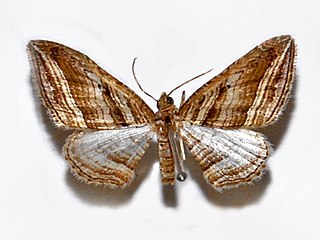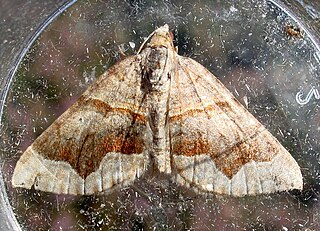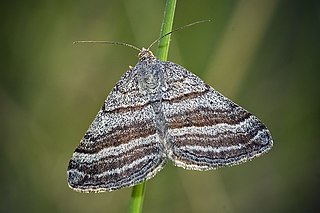
The pale November moth is a moth of the family Geometridae. The species was first described by Allen in 1906. It is a fairly common species in Western Europe including the British Isles.

Larentiinae is a subfamily of moths containing roughly 5,800 species that occur mostly in the temperate regions of the world. They are generally considered a subfamily of the geometer moth family (Geometridae) and are divided into a few large or good-sized tribes, and numerous very small or even monotypic ones which might not always be valid. Well-known members are the "pug moths" of the Eupitheciini and the "carpets", mainly of the Cidariini and Xanthorhoini. The subfamily was described by Philogène Auguste Joseph Duponchel in 1845.

Townsend's big-eared bat is a species of vesper bat.

Scotopteryx is a genus of moths of the family Geometridae described by Jacob Hübner in 1825. It is suspected that some species currently placed here actually belong in Entephria.

Scotopteryx chenopodiata, the shaded broad-bar, is a moth of the family Geometridae. It was first described by Carl Linnaeus in his 1758 10th edition of Systema Naturae.

Entephria is a genus in the geometer moth family (Geometridae). There is no unambiguous common name for these moths; like many other members of their subfamily Larentiinae, they are sometimes called "carpets". The genus was erected by Jacob Hübner in 1825.
Hoplocentra is a genus of moths belonging to the family Tineidae. It contains only one species, Hoplocentra mucronata, which is found in Uganda.

Scotopteryx moeniata, the fortified carpet, is a moth of the family Geometridae. The species was first described by Giovanni Antonio Scopoli in his 1763 Entomologia Carniolica. It is found in most of Europe except the north. It is also found in the Near East.

Xanthorhoini is a tribe of geometer moths under subfamily Larentiinae. The tribe was described by Pierce in 1914.

Scotopteryx bipunctaria, also known as the chalk carpet, is a moth in the family Geometridae. The species was first described by Michael Denis and Ignaz Schiffermüller in 1775. It is found from Morocco and Spain through western and central Europe and Great Britain to the Ural. In the north it is found up to the Baltic region and in the south its range extends over Italy and the Balkan Peninsula up to the Black Sea and Caspian Sea.

Scotopteryx coarctaria is a species of moth in the family Geometridae. It is found in most of Europe, except Ireland, Great Britain, Portugal, Belgium, Fennoscandia and the Baltic region. It has also been recorded from Turkey and Kazakhstan. There are probably two generations per year.

Scotopteryx luridata, the July belle, is a species of moth in the family Geometridae. It is found in most of Europe, except Finland and the Baltic region. Further East it is found in Turkey, Georgia and Transcaucasia.

Scotopteryx peribolata, the Spanish carpet, is a species of moth in the family Geometridae. It is found in Spain, Portugal, France, Switzerland and Great Britain, where it is found on the Channel Islands and on occasion along the southern coast of mainland Britain.

Rhizophora mucronata is a species of mangrove found on coasts and river banks in East Africa and the Indo-Pacific region.

Scotopteryx coelinaria is a species of moth in the family Geometridae. It is found in Portugal, Spain, Andorra and the French Pyrenees.

Scotopteryx kurmanjiana is a species of moth of the family Geometridae first described by Hossein Rajaei and Gyula M. László in 2014. It is found on both sides of Kopet-Dagh Mountains in north-eastern Iran and southern Turkmenistan.

Scotopteryx kuznetzovi is a species of moth of the family Geometridae. It was first described by C. A. Wardikian in 1957. It is found in Iran and Turkey.

Scotopteryx vittistrigata is a species of moth of the family Geometridae.
Cissusa mucronata is a moth of the family Erebidae. It is found in North America, where it has been recorded from Arizona and Texas.
















